
views
Answering Expository (Informative) Prompts

Look for the words "explain" or "describe" in the writing prompt. Expository prompts direct you to write an essay that explains or describes something. This type of essay is informative, but often does not require that you make an in-depth argument or state an opinion. Other words that signal an expository writing assignment include "summarize," "clarify," or "tell about." For example, "Explain camping to a person who has never camped before" is an example of an expository prompt. So is "Describe how communication has changed in the last 20 years."

Brainstorm about what the prompt is asking you to write about. Make sure you don't try to cover so much that 5 paragraphs is inadequate. You should also avoid a focus that's so narrow that you have problems coming up with 5 paragraphs. For example, for "Explain camping to a person who has never camped before," you could take several approaches. You could explain reasons why people might want to go camping, or you could explain how to set up a campsite. You might even want to try both approaches in your essay.

Create a thesis statement. For expository essays, the thesis statement says what you will be explaining or describing and how you will do it. Strong expository essays have a theme or center of gravity that organizes them. For example, for "Describe how communication has changed in the last 20 years" you might want to focus your essay on how teens use communication differently, or the impact of communication changes on daily life. An expository thesis statement does not have to present an opinion or even make an argument. It should be based on the facts you will examine. For example, "Over the past 20 years, communication has changed significantly. It is now affordable to stay in touch with people all over the world, easier to connect with people from different places and cultures, and keep others updated with even your minor doings."
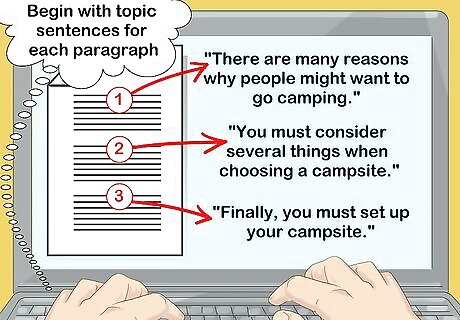
Think of strong topic sentences that support your thesis statement. A topic sentence is specific, and gives a "preview" of what the paragraph will be about. Each paragraph needs a strong topic sentence at the beginning. For example, if you were writing an essay explaining camping, you might have the following topic sentences for your paragraphs: 1) "There are many reasons why people might want to go camping." (Paragraph about reasons to go camping.) 2) "You must consider several things when choosing a campsite." (Choosing a campsite paragraph.) 3) "Finally, you must set up your campsite." (Paragraph about setting up camp.)

Compose the introduction for your essay. Your thesis statement will be the last sentence. You'll want to open with a general statement about your topic that "hooks" your reader. Then provide any context your reader needs to understand your topic. Close with your thesis statement.
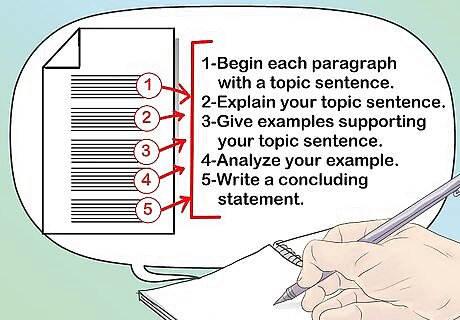
Write the body of the essay. Depending on your prompt, your answer may be as short as a paragraph. Most writing assignments expect several paragraphs, and many prefer the 5-paragraph form. For each paragraph, develop it by doing the following: Begin each paragraph with a topic sentence. Explain your topic sentence. Give an example that supports your topic sentence. Analyze your example. Write a concluding statement.

Add your conclusion. Restate your thesis at the end of the paragraph. A good conclusion will show how your ideas progressed, give the reader something to think about, or present new directions for the information. For example, if you are explaining camping, you could conclude by saying something like, "Although some people who live in cities have never been camping before, it is actually fun and easy. Next time you're considering a vacation, why not consider camping?"
Answering Narrative Prompts

Find the words "tell," "time" or "event." Narrative prompts ask you to tell a story, usually about yourself. You may also see the words "Describe" or "write about." For example, a narrative prompt might look like this: "Talk about a time when you experienced friendship" or "Describe a moment when you showed courage."

Write a story about something that happened to you. You'll want to gear the narrative you tell to answer the prompt. You will often want to write about a moment that taught you a lesson or had an impact on your life. Write in first person. Tell the story as yourself, using "I" and "me."

Begin with an introduction that tells the reader that you will tell a story. Your introduction provides the setting and context for your narrative. Let the reader know what you will be writing about, who the major "characters" are, and the purpose of your narrative. This purpose is your thesis statement. A narrative thesis statement may offer the lesson you learned or talk about the impact of the moment on your life, such as "The most memorable moment in which I showed courage happened in seventh grade." It could also identify a theme that connects your story to a greater theme, such as "Most people do not know how courageous they can be until they're faced with danger. This was true for me, too."

Write a narrative essay more loosely than you would other types of essays. Use description, metaphor, anecdotes, dialogue and other literary devices. You may want to structure your essay chronologically to show the development of the lesson over time. This is usually the clearest way to structure your essay. Use words such as "then," "next," and "finally" to show your progress.

End the essay by telling the reader what you learned from the experience. This is where you come back to the thesis you gave in the beginning. What did you learn? How has the experience changed you in some way?
Answering Persuasive Prompts
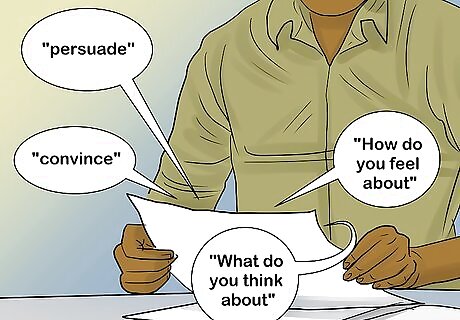
Look for the words "persuade" or "convince." Persuasive prompts direct you to make an argument that convinces another person of your point of view or opinion. You will need to use logic and examples to convince the other person. You may be trying to convince the tester who will read your essay, or you may be asked to write as if you were trying to convince a hypothetical person. Other signals that you are writing a persuasive answer include "How do you feel about" or "What do you think about". If a prompt asks whether you agree or disagree with a statement, it is a persuasive prompt.
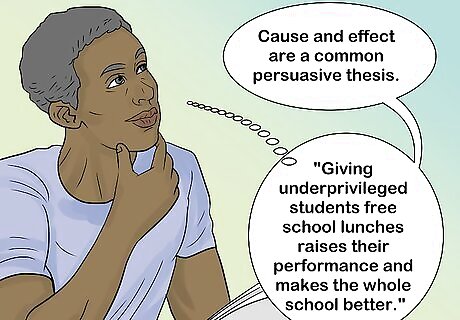
Decide which arguments will work best on the reader. This will depend on who your audience is. For example, if you have been directed to convince a hypothetical committee to fund a project, you will want to use logical, factual arguments. If you have been instructed to persuade your peers that school lunches are important, you may want to use more emotional arguments. Cause and effect are a common persuasive thesis. For example, "Giving underprivileged students free school lunches raises their performance and makes the whole school better" is a cause and effect argument. Value is another common tactic. This type of argument emphasizes the importance of something. For example, "Allowing global warming to continue will destroy habitats for animals such as polar bears and penguins. We cannot allow our world to lose this rich wildlife."
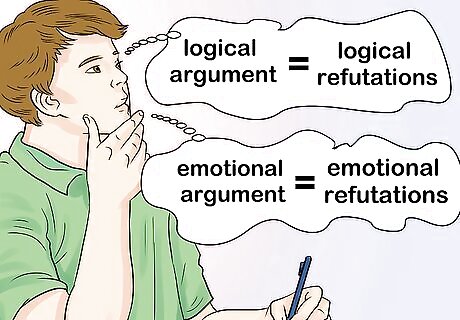
Identify what your reader's most likely objection or argument might be and how you can refute it. These possible objections may even be in the prompt itself. Read it carefully and consider what possible objections could be. For example, someone might object that providing free school lunches places a burden on taxpayers, or singles students out as "poor" in the eyes of their classmates. To refute these objections, consider the type of argument you want to make. If you're making a logical argument, use logical refutations. If you're making an emotional argument, use emotional refutations.

Write an introductory paragraph in which you give background on the issue. Give the important context or information that your readers need to know. End with a thesis statement that tells the reader what you want to persuade her to believe. For example, if you are writing about the necessity of stopping global warming, you will need to identify what scientists believe are the main causes of it. End with your thesis that states that although it will be difficult to stop global warming, we cannot afford to lose the rich wildlife that global warming is destroying.
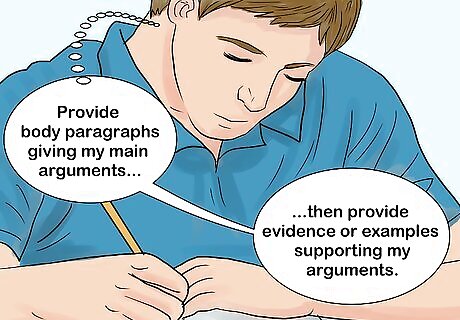
Add body paragraphs. Depending on the instructions in your prompt, provide body paragraphs that give your main arguments. In each paragraph, provide evidence or examples that support your arguments. Most persuasive essays will include at least 3 body paragraphs.

Include a paragraph in which you state the most likely argument or objection of your reader, and then refute it. This paragraph usually comes right before the conclusion. Use the information from your brainstorming session to refute the point.
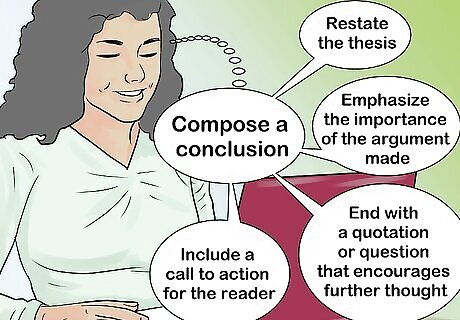
Compose a conclusion. Persuasive conclusions often end by restating the thesis and emphasizing the importance of the argument you have made. You can also include a call to action for the reader, or end with a quotation or question that encourages further thought.


















Comments
0 comment